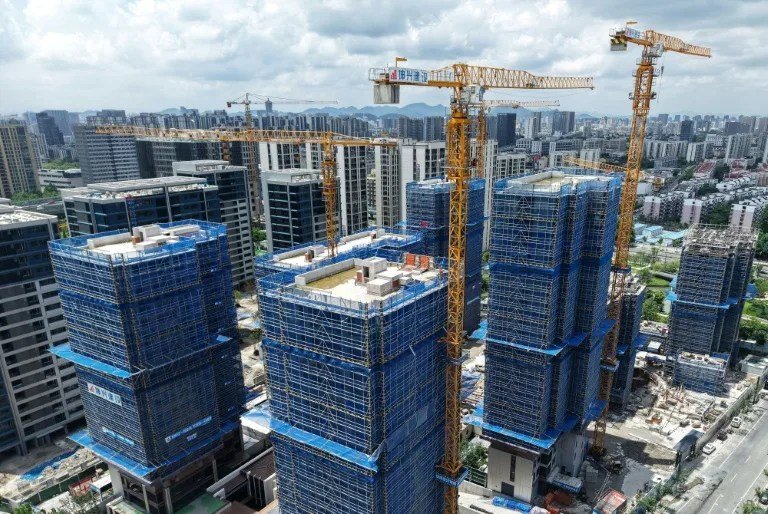China’s economy continued to show signs of fragility last month, with official data released on Monday revealing that industrial production and consumer spending grew at their slowest pace in roughly a year. The figures underscore the challenges Beijing faces in reviving the world’s second-largest economy, which has struggled to regain its pre-pandemic momentum amid a faltering property market and mounting pressures on exports.
According to the National Bureau of Statistics (NBS), industrial output in August rose 5.2 percent year-on-year, marking the slowest pace since the same month last year. Retail sales, another key indicator of domestic demand, climbed 3.4 percent, missing the 3.8 percent forecast in a Bloomberg survey of economists and representing the slowest growth since November 2024. Analysts say the data point to persistent softness in consumer confidence, which is weighing on overall activity and casting doubt over China’s official growth target of around 5 percent for 2025.
“The property market decline is a key driver behind soft consumer sentiment, which continues to dampen retail sales,” said Lynn Song, chief economist for Greater China at ING. She noted that the retail sales growth missed expectations, highlighting continued weakness in domestic spending.
China’s once-booming real estate sector, which has long been a pillar of economic growth, remains mired in a debt crisis. Since 2020, the sector has faced challenges as the liabilities of major property developers soared and numerous construction projects stalled. The NBS reported that in August, new residential property prices fell year-on-year in 65 of 70 cities surveyed, reinforcing concerns about the market’s prolonged downturn.
“While some of the slowdown reflects temporary disruptions, underlying growth is clearly sliding, raising pressure on policymakers to step in with additional support,” said Zichun Huang, a China economist at Capital Economics. “Sentiment remains soft despite a slew of measures over the past year.”
China’s Economy Shows Signs of Weakening as Factory Output and Consumer Spending Slow
In response to sluggish domestic demand, Chinese authorities have implemented a range of stimulus measures since 2024, including consumer subsidies and the removal of certain restrictions on homebuying. However, these measures have yet to produce significant improvement, as households remain cautious in their spending. Recent data show that consumer prices fell in August at the fastest rate in six months, signalling a potential deflationary trend that could further depress economic growth.
The labour market has also shown signs of strain. Urban unemployment ticked up slightly to 5.3 percent in August, compared to 5.2 percent in July. Analysts warn that without an uptick in economic activity, employment conditions could worsen, putting additional pressure on policymakers to act.
“Forward signals on the labour market haven’t improved as growing external headwinds cloud the outlook,” said Sheana Yue of Oxford Economics. “If the sluggish activity of July and August continues into the fourth quarter, the economy could fall off a cliff, highlighting the urgent need for stimulus measures.”
China’s economic challenges are compounded by global uncertainties, particularly tensions with the United States. Relations between Beijing and Washington have remained strained over trade, technology, and geopolitical disputes, creating additional headwinds for Chinese exports. In recent weeks, both countries imposed escalating tariffs on each other, intensifying uncertainty for manufacturers and exporters.
Officials from the two sides began a new round of talks in Madrid on Sunday, aiming to resolve disputes over tariffs and other trade-related issues. While the talks are seen as a step toward easing tensions, economists warn that global headwinds will likely continue to weigh on China’s economic performance in the near term.
NBS chief economist Fu Linghui acknowledged the challenges during a Monday news conference, noting that domestic demand remains weak and that some enterprises are facing operational difficulties. He emphasised that uncertainty in the external environment continues to pose risks to economic growth.
Overall, the latest data underscore the delicate balancing act facing Chinese policymakers. With consumer spending subdued, industrial activity slowing, and the property market struggling, authorities must find ways to stimulate growth while managing financial and geopolitical risks. Analysts say that without decisive intervention, China’s economy could continue to lose momentum, potentially falling short of the government’s growth objectives for the year.
The combination of internal weaknesses and external pressures highlights a critical period for China’s economy. Policymakers must act quickly to boost confidence, stimulate demand, and stabilise key sectors, all while navigating an increasingly complex global trade landscape.
Source- UK.Finance

